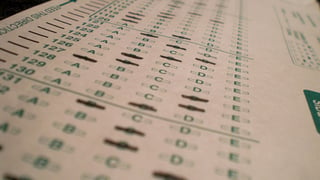Where you are
You're used to finding success in your academic life. You may not be the absolute best student in your school, but you're definitely right there at the top. So, obviously, you want to see that same level of success on the SAT to help you get into your first choice college. You did pretty well on the PSAT, National Merit material for sure, and have done a bit of prep work on your own, or maybe with some guidance from your school. But there's a problem. You're not getting the score you think you should. It's not a bad score, maybe a 1350 or a 1400, but you're used to being in the 99th percentile, not the 90th.
Where you want to be
You want a 1600, sure, but really you just want to see your SAT match your GPA instead of having to explain an embarrassing gap between them. You're willing to put in the time and effort, but you're busy. School is overwhelming on its own and you've got sports or music or any number of those extracurriculars that are also going to be essential on your college application. What you want is to make sure you're putting in the most efficient practice possible, to get as close to 1600 as you can.
Check Yourself
Before you dive headfirst into taking a million practice tests, there's a couple things that could make immediate improvements in your score:
#1 Try an ACT practice test.
Some people do much better on one test than the other, and the only way to find out is to try them both.
#2 See if there's time accommodation available for you.
If you have extra time, that will often lead to immediate score improvement.
Step 1: Identify Weakness
The best news you could get from a practice test (aside from just getting the score you want) is that you're bad at a specific section. Why? Because the easiest way to improve your score is to focus on specific weaknesses. If you struggle in the Math, Reading, or Writing (or a more specific topic like Geometry or Grammar), you can start working only on that topic, and expect to see a quick bump in your score. Compiling a comprehensive list of the sections and topics that give you trouble is an incredibly efficient first step toward your 1600. It can help save you countless hours that you would have spent working through sections you're already nailing if you're just plowing through the whole test indiscriminately.
Step 2: Easy, Medium, Hard
Once you've identified any specific topics that are causing trouble, the next place to check for focused effort is to see if you're making mistakes on easy, medium or hard problems. Typically the SAT will rank some questions for you, but you can determine for yourself which category each question is in:
- Easy: You correct the problem immediately and see that you made a silly mistake (arithmetic error, for example)
- Medium: You see why the correct answer is correct, but only after seeing what the right answer is.
- Hard: You don't know how to answer the question correctly, or only know a very slow way to answer it.
While there are books and guide out there for specific topics on the SAT, knowing which difficulty of question you're missing can be just as useful for improving your score. Here's a general idea of how to improve on each type of difficult.
- Easy: You're missing questions you should get right. You don't need to know more, you need to increase your accuracy. Finding more methodical approaches to these questions, and implementing checks will be key.
- Medium: These are questions you can do, but that can easily trick you. Learning the specific types of tricks the SAT will use, and the goals the test-makers have will be key here.
- Hard: You will need to either master the specific content for these questions or improve your timing strategy in order to increase your success on these questions.
Step 3: Make a Plan
Now that you know what you can improve, all you need is to make a plan on how to do it! A tutor will provide expert guidance on making sure you're working efficiently, or you could create your own strategy using subject-specific prep material. However you proceed, getting this knowledge will keep you from wasting your time on practice that doesn't get you closer to 1600.
Are you looking for an SAT tutor?
Are you craving more reading material on the SAT preparation process?


Comments